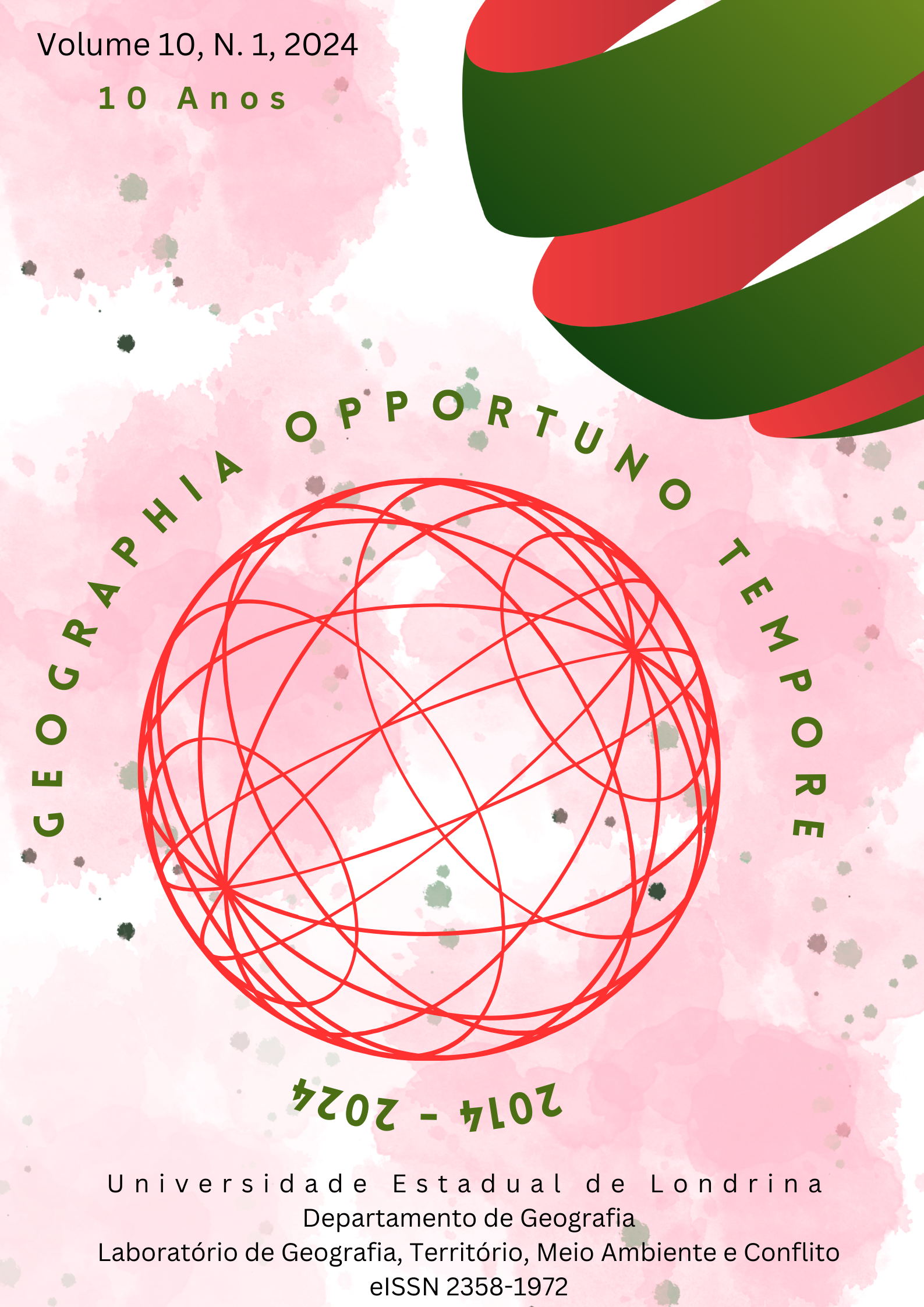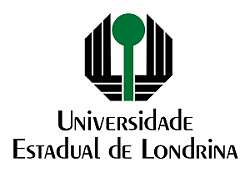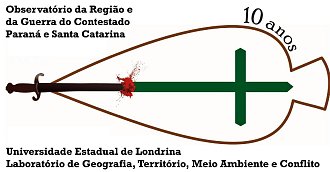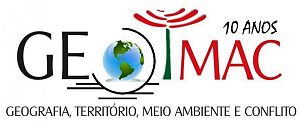The sacred space in the formation of quatro pontes-pr: between the sacred imaginary and social representations
DOI:
https://doi.org/10.5433/got.2024.v10.51313Keywords:
Geography of religion, Community identification, Symbolic-religiousAbstract
Various aspects of the symbolic-religious sphere shape the life and culture of many communities, and for this reason, we would like to reflect on the representative meanings that these aspects have within them and the sacred space of the community of Quatro Pontes in the far west of Paraná. When we seek to understand religious phenomenon, it is important to note that we are using the "imaginary" and social representations as elements for understanding social relations, and this involves understanding how shared mental images, ideas, and symbols influence and are influenced by people's perceptions and interpretations of the world around them. The Church has historically played a significant role in migration and community formation in many regions worldwide. Therefore, this investigation seeks to understand the participation and influence of the Church in the migration and constitution of the community of Quatro Pontes, whose references are supported by an expressive religious culture. In this way, we seek an investigation characterized by the geography of religion, by perceiving and analyzing the actions of settlers faithful to Christianity and the actions of the Church as an institution that fosters colonization and migratory relations characterized by cultural representations in a given geographic space.
Downloads
References
ABREU, Raphael Lorenzeto de. Imagem: Parana MesoMicroMunicip.svg, own work, CC BY 2.5. Disponível em: <https://commons.wikimedia.org/w/index.php?curid=1362765>. Acesso em: 25/8/2023.
BERGER, Peter Ludwig. O dossel sagrado: elementos para uma teoria sociológica da religião. São Paulo: Paulus, 1985.
BERGER, Peter Ludwig; LUKMANN, Thomas. Construção da realidade: Tratado de sociologia do conhecimento. Petrópolis: Vozes, 2014.
BOURDIEU, Pierre. Sociologia Geral vol.2: Habitus e campo: Curso no Collège de France (1982-1983). Petrópolis: Vozes, 2021.
DEITOS, Nilceu Jacob (Org.). Paróquia Nossa Senhora da Glória: Quatro Pontes - PR: meio século de história. Toledo: Gráfica Tuicial e Editora, 2005.
DIOCESE DE TOLEDO (2023). Disponível em: <https://www.diocesetoledo.org/webfiles/imagens/20230202_63dbd24cbd0f7.jpeg>.Acesso em: 28/8/2023.
DURKHEIM, Émile. As formas elementares da vida religiosa. São Paulo: Paulus Editora. 2001.
ELIADE, Mircea. O sagrado e o profano. São Paulo: Martins Fontes, 2001.
FRAGA, Nilson Cesar.; BUENO, Victória Jandira. A ideia de Sertão na Formação Socioterritorial Brasileira, e na Região da Guerra do Contestado. Caminhos de Geografia, v. 24, p. 34-48, 2023. DOI: https://doi.org/10.14393/RCG249566632
FRAGA, Nilson Cesar. Geografias de tempos de dominação e barbárie: os movimentos socioterritoriais e as escolhas geográficas que negligenciam a formação territorial do Brasil. In: Flamarion Duarte Alves, Sandra de Castro de Azevedo, Estevan Leopoldo de Freitas Coca, Ana Rute do Vale. (Org.). A Dimensão política no espaço: conflitos e desigualdades territoriais na sociedade contemporânea. 1ªed.Alfenas, MG: Editora da Universidade Federal de Alfenas, 2019, v. 1, p. 84-114.
FRAGA, Nilson Cesar. Territórios e Fronteiras: (Re)arranjos e Perspectivas. 2ª. ed. Florianópolis, SC: Editora Insular, 2017.
FRAGA, Nilson Cesar. Territórios Paranaenses. Florianópolis, SC: Editora Insular, 2011.
FRAGA, Nilson Cesar.; KLUEGER, Urda. Alice. Formação territorial paranaense: uma análise espacial e temporal. In: Nilson Cesar Fraga. (Org.). Territórios Paranaenses. Florianópolis, SC: Editora Insular, 2011, v. 1000, p. 283-302.
FRAGA, Nilson Cesar. Geografia do Paraná: formação sócio-espacial, uma leitura do processo. In: Universidade Livre do Meio Ambiente - UNILIVRE. (Org.). Mapas & Maquetes: elementos históricos e geográficos do Paraná. Curitiba, PR: Unilivre, 2002, v. 1, p. 41-73.
FRAGA, Nilson Cesar. Ocupação Formação e Desenvolvimento do Estado do Paraná - contribuições geográficas. In: Universidade Livre do Meio Ambiente - UNILIVRE. (Org.). História e Geografia do Paraná: textos e metodologias de mapas e maquetes. Curitiba, PR: Unilivre, 2002, v. 1, p. 45-81.
GIL FILHO, Fausto. Geografia Cultural: Estrutura e Primado das Representações. In: Espaço e Cultura. - N. 3 - Rio de Janeiro:UERJ, 1996.
GREGORY, Valdir. Os eurobrasileiros e o espaço colonial: migrações no oeste do Paraná (1940-70). Cascavel: EDUNIOESTE, 2002.
KOZEL, Salete. As representações no Geográfico. In: MENDONÇA, F.; KOZEL, S. (Org.). Elementos de epistemologia da Geografia Contemporânea. Curitiba: Editora UFPR, 2002.
MARIPÁ, Industrial Madeireira e Colonizadora Rio Paraná S/A. Relatório do Plano de colonização (Teórico e Prático) 1946-1960. Texto mimeografado. Acervo Museu Willy Barth, Toledo-PR. Porto Alegre, 1960.
MOSCOVICI, Serge. Representações Sociais: investigações em psicologia social. Petrópolis: Vozes, 2003.
QUATRO PONTES. Disponível em: <https://quatropontes.pr.gov.br/upload/19413000615f6c93a9493fa4.31607085.jpg>. Acesso em: 23/8/2023.
STATIC (2023). Disponível em: <https://static.wixstatic.com/media/42f567_d1d7bb1a23e44983bd54436995254446~mv2.png>. Acesso em: 27/8/2023.
Downloads
Published
How to Cite
Issue
Section
License
Copyright (c) 2024 Fabiano Feldhaus, Juçara Deimling

This work is licensed under a Creative Commons Attribution 4.0 International License.
Aviso de Direito Autoral Creative Commons
1. Política para Periódicos de Acesso Livre
Autores que publicam nesta revista concordam com os seguintes termos:
- Autores mantém os direitos autorais e concedem à revista o direito de primeira publicação, com o trabalho simultaneamente licenciado sob a Licença Creative Commons Attribution que permite o compartilhamento do trabalho com reconhecimento da autoria e publicação inicial nesta revista.
- Autores têm autorização para assumir contratos adicionais separadamente, para distribuição não-exclusiva da versão do trabalho publicada nesta revista (ex.: publicar em repositório institucional ou como capítulo de livro), com reconhecimento de autoria e publicação inicial nesta revista.
- Autores têm permissão e são estimulados a publicar e distribuir seu trabalho online (ex.: em repositórios institucionais ou na sua página pessoal) a qualquer ponto antes ou durante o processo editorial, já que isso pode gerar alterações produtivas, bem como aumentar o impacto e a citação do trabalho publicado (Veja O Efeito do Acesso Livre)
- Os autores cedem à Geographia Opprrtuno Tempore, direitos exclusivos de primeira publicação, com o trabalho simultaneamente licenciado sob a Licença Atribuição-NãoComercial-
CompartilhaIgual 4.0 Internacional. Esta licença permite que terceiros façam download e compartilhem os trabalhos em qualquer meio ou formato, desde que atribuam o devido crédito de autoria, mas sem que possam alterá-los de nenhuma forma ou utilizá-los para fins comerciais. Se você remixar, transformar ou desenvolver o material, não poderá distribuir o material modificado




















